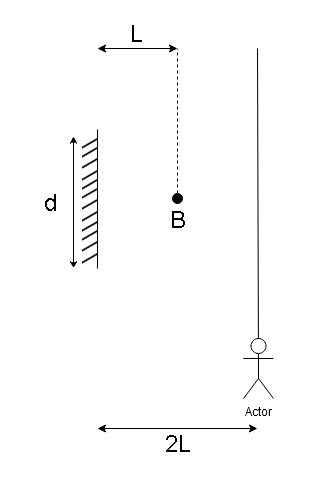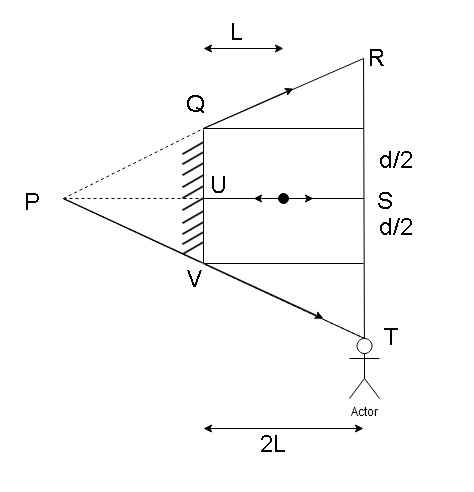
A point source of light B is placed at a distance $L$ in front of the center of a mirror of width $d$, hung vertically on a wall. A man walks in front of the mirror along a line parallel to the mirror at a distance $2L$ from it as shown in the figure. The greatest distance over which he can see the image of the light source in the mirror is:

A.) $\dfrac{d}{2}$
B.) $d$
C.) $2d$
D.) $3d$

Answer
579.9k+ views
Hint: You can start by explaining what the distance of the image will be from the mirror. Then draw a well labelled diagram of the given situation, including the distance over which the man can see the source of light B in the mirror. Then use similarity between two triangles to find out half the distance over which the man can see the point source of light in the mirror. Then multiply it by two to get the result.
Complete step by step answer:
The distance of the image from the plane mirror is the same as the distance of the object from the mirror.
So, in this case the image of the point source of light B will be at a distance $L$ from the mirror.
For the person to see the source of light B, a ray of light emerging from the point source of light B has to reach the man after striking the plane mirror.
The diagram given in the problem can be redrawn as follows

$\because \angle QPU = \angle RPS$
And $\angle QUP = \angle RSP = 90^\circ $
Thus, $\Delta PQU$ and $\Delta PRS$are similar
$\therefore \dfrac{{PU}}{{PS}} = \dfrac{{QU}}{{RS}}$
$\dfrac{L}{{2L + L}} = \dfrac{{\dfrac{d}{2}}}{{RS}}$
$\dfrac{1}{3} = \dfrac{d}{{2(RS)}}$
$RS = \dfrac{{3d}}{2}$.
Thus, the man can see the point of source of light B in the mirror at a distance $\dfrac{{3d}}{2}$ above and below point $S$. Thus the man can see the point of source of light B in the mirror for a total distance of $\dfrac{{3d}}{2} + \dfrac{{3d}}{2} = 3d$ .
Hence, the correct answer is option D.
Note:
Plane mirror is essentially a rectangular glass slab with a really smooth surface and is coated on one side by silver. Plane mirrors always produce an upright, virtual image. The size of the image is the same size as the object. The distance of the image from the plane mirror is the same as the distance of the object from the mirror.
Complete step by step answer:
The distance of the image from the plane mirror is the same as the distance of the object from the mirror.
So, in this case the image of the point source of light B will be at a distance $L$ from the mirror.
For the person to see the source of light B, a ray of light emerging from the point source of light B has to reach the man after striking the plane mirror.
The diagram given in the problem can be redrawn as follows

$\because \angle QPU = \angle RPS$
And $\angle QUP = \angle RSP = 90^\circ $
Thus, $\Delta PQU$ and $\Delta PRS$are similar
$\therefore \dfrac{{PU}}{{PS}} = \dfrac{{QU}}{{RS}}$
$\dfrac{L}{{2L + L}} = \dfrac{{\dfrac{d}{2}}}{{RS}}$
$\dfrac{1}{3} = \dfrac{d}{{2(RS)}}$
$RS = \dfrac{{3d}}{2}$.
Thus, the man can see the point of source of light B in the mirror at a distance $\dfrac{{3d}}{2}$ above and below point $S$. Thus the man can see the point of source of light B in the mirror for a total distance of $\dfrac{{3d}}{2} + \dfrac{{3d}}{2} = 3d$ .
Hence, the correct answer is option D.
Note:
Plane mirror is essentially a rectangular glass slab with a really smooth surface and is coated on one side by silver. Plane mirrors always produce an upright, virtual image. The size of the image is the same size as the object. The distance of the image from the plane mirror is the same as the distance of the object from the mirror.
Recently Updated Pages
A man running at a speed 5 ms is viewed in the side class 12 physics CBSE

The number of solutions in x in 02pi for which sqrt class 12 maths CBSE

State and explain Hardy Weinbergs Principle class 12 biology CBSE

Write any two methods of preparation of phenol Give class 12 chemistry CBSE

Which of the following statements is wrong a Amnion class 12 biology CBSE

Differentiate between action potential and resting class 12 biology CBSE

Trending doubts
What are the major means of transport Explain each class 12 social science CBSE

Which are the Top 10 Largest Countries of the World?

Draw a labelled sketch of the human eye class 12 physics CBSE

How much time does it take to bleed after eating p class 12 biology CBSE

Explain sex determination in humans with line diag class 12 biology CBSE

Explain sex determination in humans with the help of class 12 biology CBSE




